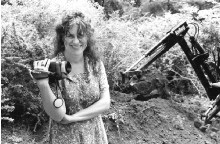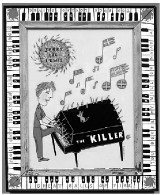From hanging out with R.E.M. in Athens, Georgia, to showing her paintings in Rome, to documenting local folklore hidden in the Catskills, Laura Levine '79 has followed a kaleidoscope of career paths.
Her artistic journey began at the Crimson, where she pursued a fledgling interest in photography and became increasingly interested in rock and roll, while concentrating in cultural anthropology. After graduation she plunged into a career as a free-lance photographer and maker of music videos. But by the mid 1990s, she was disillusioned with what seemed to her the growing commercial tone of the music scene. "When I first started shooting," she recalls, "it was just you and the band."
 |  |
| Laura Levine captured on the set of Digging for Dutch (above), and a sample of her non-cellular artwork (right), a portrait of Jerry Lee Lewis from Shake, Rattle & Roll. | |
To take a break, she moved to Phoenicia, New York, in the Catskills, and opened Homer and Langley's Mystery Spot, an antiques and junk shop. Painting, which she had taken up as a self-taught hobby, evolved into new creative endeavor. As her old love of music resurfaced, Levine combined it with her "folksy" painting to illustrate two children's books: Wig!, a collaboration with the B-52s, and the recently published Shake, Rattle & Roll: The Founders of Rock & Roll.
Forays into Phoenicia, meanwhile, were inspiring her to explore a new artistic medium. "I began hearing these local legends, including the tale of Dutch Schultz," she remembers. "He apparently spent a lot of time in Phoenicia to get away from the city, and when he thought he was in danger of getting killed, he buried his treasure up there so no one could get to it. Then he was killed before he could escape the city and retrieve it, and no one has ever found it."
The mysterious whereabouts of Schultz's treasure, and the continuous stream of people who came searching for it, intrigued Levine. "I decided I would look for the treasure myself," she recalls with a laugh. "I read up on mountain folkfore and interviewed lots of old-timers who knew the tales, and soon I had a completed manuscript." She decided to transform her research into a film, and after five years of "lots and lots of time, money, and energy," produced the documentary Digging for Dutch: The Search for the Lost Treasure of Dutch Schultz. The film premiered at the 2001 Woodstock Film Festival, winning the Torchlight Award for best feature film; it is now making the rounds of other film festivals.
In her documentary work, Levine says, she tries to combine her studies in cultural anthropology and her visual skills. Digging for Dutch, she goes on to explain, "is really about people's obsessions and passions--what it means to follow one's dreams....The moral of the film is that there's a lot of treasure out there, and it's all in how you define it."
~Harriett E. Green





